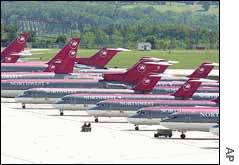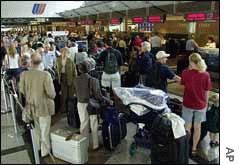|
Airlines face cash crunch
|
 |
September 14, 2001: 6:05 p.m. ET
Trade group says industry has only 30 days cash; federal aid a possibility
By Staff Writer Chris Isidore
|
NEW YORK (CNNfn) - The nation's airlines have only enough cash to survive for about 30 days because of public fear of flying in the wake of Tuesday's terrorist attack, according to an economist with the industry's trade group.
John Heimlich, director of economic and market research for the Air Transport Association, said the industry is considering whether to seek federal assistance to prevent carriers from going out of business.
He said airlines are selling virtually no new tickets; flights that have resumed are carrying almost solely those passengers who already had bought tickets. But, he said, the industry is incurring costs of about $350 million a day, and as a group had only about $10 billion cash on hand before the incident.
| |

|
|
Grounded jets and dropping demand for air travel could mean big financial problems for the nation's airlines. | |
"We're an industry notorious for high fixed costs," he said. "Some carriers have far greater positions than others. But there is no new cash coming in and there is cash going out."
The help Heimlich says the industry needs could be on the way. Congressional sources told CNN Friday that Republican and Democratic leaders in the House of Representatives have agreed in principle to a $2.5 billion emergency bailout package for the U.S. airline industry.
They say they hope to approve the package as early as Friday night in the House. Majority Whip Rep. Tom DeLay, R-Texas, says the $2.5 billion would be carved out of the $40 billion emergency appropriation that was passed Friday in both the House and Senate, although another House leader, GOP Conference Chairman J.C. Watts (R-Okla.), said those details are not finalized.
DeLay also said the money would be used as cash payments directly to the airlines.
One carrier, Midway Airlines, which already was operating under bankruptcy court protection, announced this week it will cease operations altogether.
Heimlich said that the industry will need financial assistance from the government to avoid closures among even major carriers.
"Midway is only going to be the first," he predicted. He said airlines still are struggling to determine how steeply air travel will fall as a result of the attack.
"In the past, things have been incredibly resilient. This is completely different," he said. "Do you want to fly? Ask your 10 neighbors if they want to fly. If nine say no, you may have your answer."
Heimlich said the industry was in financial trouble even before Tuesday's attacks. Analysts' forecasts already had put industry losses at more than $3 billion this year, and only two major carriers – No. 5 Continental Airlines (CAL: Research, Estimates) and No. 7 Southwest Airlines (LUV: Research, Estimates), have been able to report profits in the first two quarters of the year, and they were the only ones expected to post an annual profit before the disaster.
Credit rating agency Standard and Poor's put all major airlines' long-term and short-term corporate credit, bank loan and other securities ratings on a negative credit watch, meaning the agency expects to drop the ratings further.
"In contrast to previous terrorist incidents affecting aircraft on international routes, these attacks involved multiple domestic flights. As a result, the effect on passenger demand is likely to be more widespread. The enormity of the New York and Washington incidents, and the resulting investigations and possible U.S. military response, will keep the events in the public eye for a significant period," the agency said.

|
|
|
Flights were full when flying resumed this week, but that was mostly due to people who already had tickets trying to get home. The Air Transport Association says there's been virtually no demand for new tickets. | |
S&P also pointed out that new restrictions on cargo shipments in passenger planes will further hurt revenue, and the expected rising cost of new security measures and possibly higher fuel prices will raise overall costs.
There is a real risk of bankruptcies among U.S. carriers, said Virginia Casin, associate director of S&P's corporate rating service. She would not point to any airline facing an immediate liquidity crisis. But she pointed out that a number of major carriers already had junk-bond status for their debt.
UAL Corp. (UAL: Research, Estimates), the world's second-largest airline company and operator of United Airlines, has a BB+ rating, the highest rating a company can have without its debt being considered investment grade.
Three other carriers have only B ratings on their debt – No. 6 carrier US Airways Group Inc. (U: Research, Estimates), discount carrier AirTran Holdings Inc. (AAI: Research, Estimates), which took over the former ValuJet, and Atlantic Coast Airlines Holdings Inc. (ACAI: Research, Estimates), which flies feeder flights for United and Delta Air Lines.
Even with these carriers' limited financial resources, Casin said, it's too early to know how quickly they could find themselves in a liquidity crisis.
"We can't sure we can measure the extent of the difficulties at this stage," she said. "It's very difficult to measure how passenger attitudes will evolve, how low the passenger load factors will be."
A spokeswoman for United said she couldn't comment on the airline's financial situation at the current time, saying it was focused on helping the families of those killed in its two hijacked flights Tuesday.
Representatives of American and Delta (DAL: Research, Estimates), both of which Casin said are in relatively strong financial position in terms of resources and debt ratings, said they don't yet have a sense of costs to their companies at this time.
Airlines weigh significant cut in flights
"Clearly the costs are huge. Just the lost revenue itself is substantial, plus all the other expense involved in a tragedy like this," American spokesman Al Becker said. "We were already having an extremely difficult year. This will only exacerbate that. But this remains a fundamentally sound company."
But for the foreseeable future it will be a smaller company, operating only about 80 percent of its schedule for the foreseeable future, Becker said. It even may have to cut back from that goal based on demand and the constraints of the new security procedures, he conceded. That's a huge drop in capacity for a carrier that had been looking at only a 1 percent drop in capacity next year due to the slowdown in business travel before Tuesday's attack.
Still, Becker said, it's too soon to talk about staff cuts or furloughs, despite the plans to operate a much smaller than normal system for the foreseeable future.
Other airlines were not available for immediate comment, said they couldn't make a comment, or did not have specifics about bookings or increased costs or losses.
"Our main focus is getting our stranded passengers back to their final destinations," said Delta spokeswoman Peggy Estes, adding that the carrier operated about a quarter of its normal schedule from the resumption of flights Thursday afternoon through 8:30 a.m. ET Friday.
"Those flights are full," she said. "I don't know what bookings are looking forward. The bookings were obviously very soft even before this."
US Airways already was struggling with losses and had announced a turnaround plan that included smaller jets, a smaller fleet, lower wages and other moves to try to return to profitability. Officials were not available for an immediate comment on the airline's financial outlook in light of the attack.
Rick Weintraub, an spokesman for US Airways, said that the company hasn't yet decided on any changes in the turnaround plan, although everything will likely be re-evaluated in light to this week's events. He said about a third of the flights were operating Friday.
The airline had nearly $1 billion in available cash as of June 30, said Phil Baggaley, another debt analyst with S&P. So, he said, despite the worst financial position of the major carriers and the lowest debt rating, he doesn't think there's an immediate liquidity crisis.
"It is true US Airways has more competition from Amtrak and to some extent from cars from other airlines," he said, citing the carrier's dependence on shuttle service between Washington, New York and Boston. "Amtrak's Northeast Corridor service is pretty full. There's a limit to how much they can carry. US Airways doesn't have the international flights of some of the other airlines. Some of those could be more affected by security concerns."
The shuttle service has continued to be shut down by the closure of Reagan National Airport in Washington and Logan Airport in Boston. LaGuardia Airport in New York, a key point on the shuttle service route, did reopen Friday.
Baggaley said that while United Airlines had the largest losses of the major carriers, it owns most of its own planes, giving it the assets it would need to borrow additional money to meet liquidity needs, even with the current junk-bond rating on its debt.
Atlantic Coast Airlines spokesman Rick DeLisi said his airline won't be as hard hit by a drop in passenger traffic since it is paid per departure by United and Delta for flying the feeder flights to their hubs. He said there has been no discussion with those carriers about cutting back on the regional jet flights that feed passengers into their hubs. 
CNN's Ted Barrett contributed to this report.
|
|
|
|
|
 |

|

